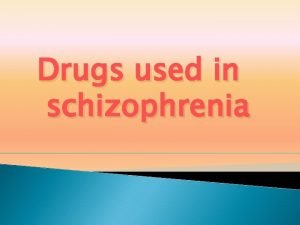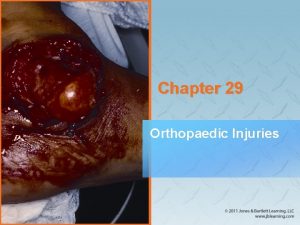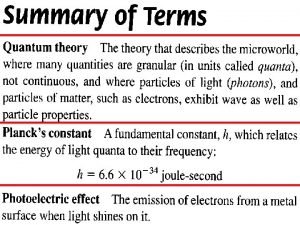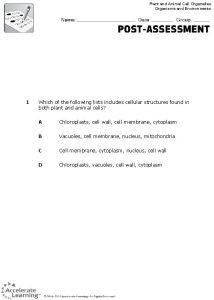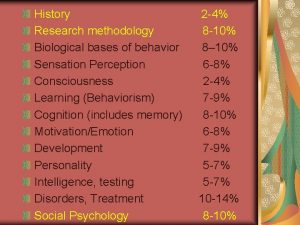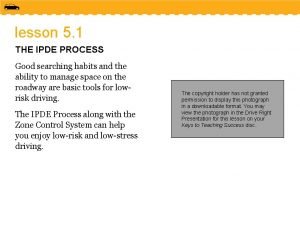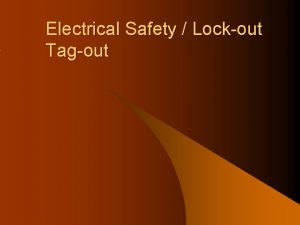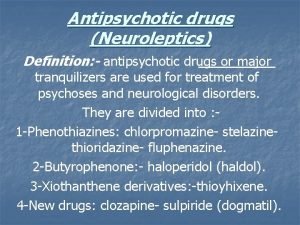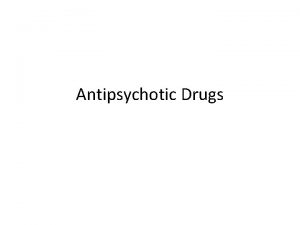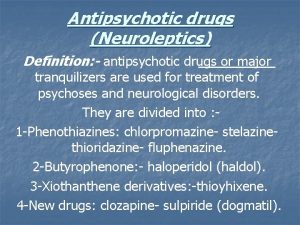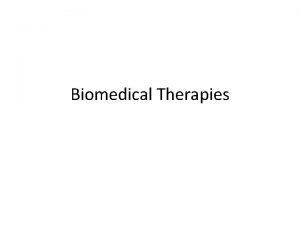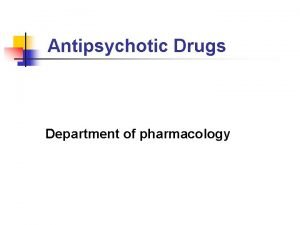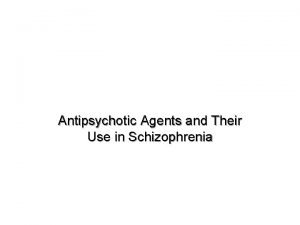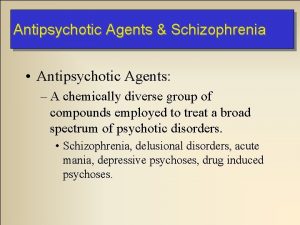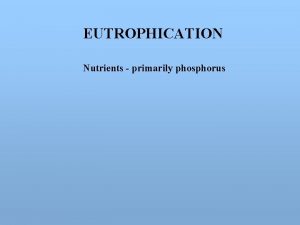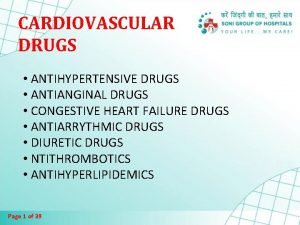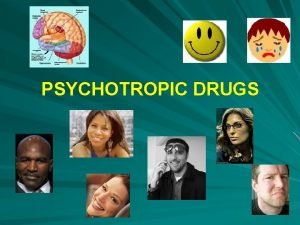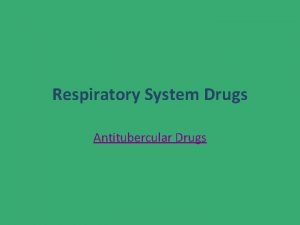The antipsychotic drugs The antipsychotic are used primarily






























- Slides: 30

The antipsychotic drugs

• The antipsychotic are used primarily to: • Treat schizophrenia. • Effective in other psychotic and manic states.

The term “psychosis” denotes a variety of mental disorders: • The presence of delusions (false beliefs). • Hallucinations, usually auditory or visual, tactile or olfactory, • Grossly disorganized thinking in a clear sensorium.

• Schizophrenia is a particular kind of psychosis characterized mainly by a clear sensorium but a marked thinking disturbance. • Schizophrenia is a type of chronic psychosis characterized by delusions, hallucinations (often in the form of voices), and thinking or speech disturbances.

• The onset of illness is during late adolescence or early adulthood. • It occurs in about 1% of the population and is a chronic and disabling disorder. • Schizophrenia has a strong genetic component and probably reflects some fundamental biochemical abnormality, possibly a dysfunction of the mesolimbic or mesocortical dopaminergic neuronal pathways.

The antipsychotic drugs are divided into: A. First-generation antipsychotics • Fluphenazine, Haloperidol, Prochlorperazine, trifluperazine. • The first-generation antipsychotic drugs (also called typical, or traditional antipsychotics) are competitive inhibitors at a variety of receptors, but their antipsychotic effects reflect competitive blocking of dopamine D 2 receptors.

• First-generation antipsychotics are more likely to be associated with movement disorders known as extrapyramidal symptoms (EPS), particularly drugs that bind tightly to dopaminergic neuroreceptors, such as haloperidol. • Movement disorders are less likely with medications that bind weakly, such as chlorpromazine.

B. Second-generation antipsychotic drugs • As clozapine, olanzapine, resperidone. • “atypical” antipsychotics have a lower incidence of EPS than the first-generation agents. • associated with a higher risk of metabolic side effects, such as diabetes, hypercholesterolemia, and weight gain. • their efficacy may exceeds, that of the firstgeneration antipsychotic agents.

• The second- generation drugs appear to owe their unique activity to blockade of both serotonin and dopamine and, perhaps, other receptors.

• Second-generation agents are generally used as first-line therapy for schizophrenia to minimize the risk of debilitating EPS associated with the first-generation drugs that act primarily at the dopamine D 2 receptor. • The second-generation antipsychotics exhibit an efficacy that is equivalent to, and occasionally exceeds, that of the first-generation antipsychotic agents.

Mechanism of action • All of the first-generation and most of the second-generation antipsychotic drugs block D 2 dopamine receptors in the brain and the periphery. • Most of the second generation agents appear to exert part of their unique action through inhibition of serotonin receptors (5 -HT), particularly 5 -HT 2 A receptors.

• Clozapine has high affinity for D 1, D 4, 5 -HT 2, muscarinic, and α-adrenergic receptors, but it is also a weak dopamine D 2 receptor antagonist. • Risperidon blocks 5 -HT 2 A receptors to a greater extent than it does D 2 receptors, as does olanzapine.

Actions • The clinical effects of antipsychotic drugs appear to reflect a blockade at dopamine and/or serotonin receptors. • they also block cholinergic, adrenergic, and histaminergic receptors and its seems that the undesirable side effects of antipsychotic drugs often result from pharmacological actions at these other receptors.

• 1. Antipsychotic effects: All antipsychotic drugs can reduce hallucinations and delusions associated with schizophrenia (known as “positive” symptoms) by blocking D 2 receptors in the mesolimbic system of the brain.

• The “negative” symptoms, such as blunted affect, apathy, and impaired attention, as well as cognitive impairment, are not as responsive to therapy, particularly with the first-generation antipsychotics. • Many second-generation agents, such as clozapine, can ameliorate the negative symptoms to some extent

2. Extrapyramidal effects: • Dystonias (sustained contraction of muscles leading to twisting, distorted postures). • Parkinson-like symptoms, akathisia (motor restlessness). • tardive dyskinesia (involuntary movements, usually of the tongue, lips, neck, trunk, and limbs) can occur with both acute and chronic treatment. • Blockade of dopamine receptors in the nigrostriatal pathway probably causes these unwanted movement symptoms. The second generation antipsychotics exhibit a lower incidence of EPS.

3. Antiemetic effects: most antipsychotic drugs have antiemetic effects that are mediated by blocking D 2 receptors of the chemoreceptor trigger zone of the medulla. 4. Anticholinergic effects: Some of the antipsychotics, clozapine, and olanzapine, produce anticholinergic effects. These effects include blurred vision, dry mouth confusion, and inhibition of gastrointestinal and urinary tract smooth muscle, leading to constipation and urinary retention.

5. Other effects: Blockade of α-adrenergic receptors causes orthostatic hypotension and light-headedness. • In the pituitary, antipsychotics block D 2 receptors, leading to an increase in prolactin release. Sedation occurs with those drugs that are potent antagonists of the H 1 -histamine receptor, including chlorpromazine, olanzapine, quetiapine, and clozapine.

Therapeutic uses 1. Treatment of schizophrenia: The antipsychotics are considered the only efficacious pharmacological treatment for schizophrenia. 2. The first-generation antipsychotics are most effective in treating positive symptoms of schizophrenia.

• The atypical antipsychotics with 5 -HT 2 A receptor–blocking activity may be effective in many patients who are resistant to the traditional agents, especially in treating the negative symptoms of schizophrenia. 2. Prevention of nausea and vomiting: The older antipsychotics (most commonly, prochlorperazine are useful in the treatment of drug-induced nausea.

• Pharmacokinetics • After oral administration, the antipsychotics show variable absorption that is unaffected by food (except for ziprasidone and paliperidone, the absorption of which is increased with food). These agents readily pass into the brain and have a large volume of distribution.

• They are metabolized to many different metabolites, usually by the cytochrome P 450 system in the liver, Some metabolites are active and have been developed as pharmacological agents themselves (for example, paliperidone is the active metabolite of risperidone.

• Fluphenazine decanoate, haloperidol decanoate are long-acting injectable formulations of antipsychotics. These formulations have a therapeutic of action of up to 2 to 4 weeks and, therefore, are often used to treat outpatients and individuals who are nonadherent with oral medications. •

Adverse effects • Adverse effects of the antipsychotic drugs can occur in practically all patients and are significant in about 80%.

• 1. Extrapyramidal effects: The inhibitory effects of dopaminergic neurons are normally balanced by the excitatory actions of cholinergic neurons in the striatum. • Blocking dopamine receptors alters this balance, causing a relative excess of cholinergic influence, which results in extrapyramidal motor effects.

• If cholinergic activity is also blocked, nearly normal balance is restored, and extrapyramidal effects are minimized. • This can be achieved by administration of an anticholinergic drug, such as benztropine. • Those antipsychotic drugs that exhibit strong anticholinergic activity, such as thioridazine , show fewer extrapyramidal disturbances. haloperidol and fluphenazine, which have low anticholinergic activity and produce extrapyramidal effects more frequently because of the preferential blocking of dopaminergic transmission.

• dystonias followed by akathisias occurring within days to weeks. Parkinson like symptoms of bradykinesia, rigidity, and tremor usually occur within weeks to months of initiating treatment. Tardive dyskinesia , which can be irreversible, may occur after months or years of treatment.

2. Tardive dyskinesia: Long-term treatment with antipsychotics can cause this motor disorder. Patients display involuntary movements, including bilateral and facial jaw movements and “fly-catching” motions of the tongue. • A prolonged holiday from antipsychotics may cause the symptoms to diminish or disappear within a few months. However, in many individuals, tardive dyskinesia is irreversible and persists after discontinuation of therapy.

• 4. Other effects: Drowsiness occurs due to CNS depression and antihistaminic effects, Those antipsychotic agents with potent antimuscarinic activity often produce dry mouth, urinary retention, constipation, and loss of visual accommodation. Others may block αadrenergic receptors, resulting in lowered blood pressure and orthostatic hypotension.

• The antipsychotics depress the hypothalamus, affecting thermoregulation and causing amenorrhea, galactorrhea, gynecomastia, infertility, and erectile dysfunction. Significant weight gain is often a reason for nonadherence. Hyperglycemia, Hyperlipidemia.
 Antipsychotic drugs classification
Antipsychotic drugs classification Insidan region jh
Insidan region jh During world war 2 this poster was used primarily to
During world war 2 this poster was used primarily to The rear end of an arrow has a slotted plastic tip
The rear end of an arrow has a slotted plastic tip Traction splints are used primarily to immobilize
Traction splints are used primarily to immobilize Radial engine valve operating mechanism
Radial engine valve operating mechanism Multilateral netting is used primarily to
Multilateral netting is used primarily to What is this
What is this Shoulder push stabilization screen
Shoulder push stabilization screen Emergency drugs used in delivery room
Emergency drugs used in delivery room Fetal hydantoin syndrome
Fetal hydantoin syndrome Light behaves primarily as a particle when it
Light behaves primarily as a particle when it Characteristics of retailing
Characteristics of retailing Animal cells
Animal cells A consumer that primarily eats one specific organism
A consumer that primarily eats one specific organism Earthquake intensity depends primarily on the height of
Earthquake intensity depends primarily on the height of According to john watson behavior is governed primarily by
According to john watson behavior is governed primarily by Population ecologists are primarily interested in
Population ecologists are primarily interested in Fuses and circuit breakers are intended primarily for the
Fuses and circuit breakers are intended primarily for the Executing in the ipde process primarily involves
Executing in the ipde process primarily involves Production process of artist and artisan
Production process of artist and artisan Prokaryotes primarily reproduce
Prokaryotes primarily reproduce Numbers pyramid owl pellet lab
Numbers pyramid owl pellet lab Ipde method of driving
Ipde method of driving Guillaume de machaut worked primarily in
Guillaume de machaut worked primarily in Fuses and circuit breakers are intended primarily for
Fuses and circuit breakers are intended primarily for Complex carbohydrates are found primarily in ____.
Complex carbohydrates are found primarily in ____. Define melody
Define melody Why do clouds form?
Why do clouds form? Picture quiz
Picture quiz 4 food chains
4 food chains
